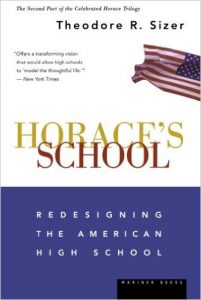George Wood on Horace’s School: Redesigning the American High School
In 1993, the year that Ted Sizer published Horace’s School, I was a first-year principal. I had left my position as a professor in a college of education to try and lead a rural school that was struggling. It was filled with good teachers (many Horaces) and fine kids, but lacked leadership, coherence, and direction. We knew we could do some great things with the resources we had, but how to go about rethinking the school?
One line in Horace’s School set us to completely rethink what school could be for children and their teachers: “Can you express this school’s program in terms of what the kids do rather than in terms of what you (the teachers) do?” This phrase guided all of our work—work that led to restructuring the school day, eliminating ability grouping, graduation standards that included a portfolio and senior project, an internship program, an advisory program, and more.
When I look back on all we have accomplished at Federal Hocking High School, I know that Horace’s School led us to a place that is better for teachers and students than we ever thought possible. It provided a new vantage point from which all things seemed possible. Indeed, they have never been the same.
George Wood is the Superintendent of the Federal Hocking Local Schools, a rural school district that serves the Stewart, Ohio region. George is the president of the Coalition of Essential Schools executive board and author of several books, including Time to Learn: How to Create High Schools That Serve All Students.
| Horace’s School: Redesigning the American High School, by Theodore R. Sizer, was published in 1992 as the the second part of the Horace trilogy. Once again featuring fictional teacher Horace Smith, Horace’s School describes Horace at the helm of a committee tasked to redesign their high school. Through this device, Sizer walks readers through actual design decisions made within the Coalition of Essential Schools, which at the time of Horace’s School‘s publication had grown to several hundred member schools and was a powerful national school reform force. Among other notable practices based on the Common Principles, Sizer offered detailed examples of exhibitions of learning throughout the text, emphasizing the central importance of deep and meaningful student work that demonstrates “intellectual merit” and highlighting the conditions, policies, and commitments required for students (no two of whom are alike) to demonstrate what they know and can do. |

